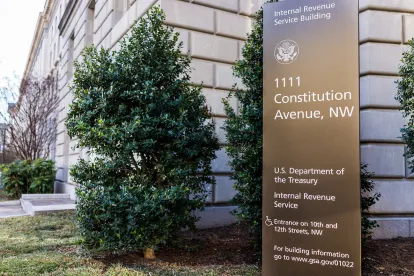On June 14, 2023, the Treasury Department and the Internal Revenue Service (IRS) released long-awaited guidance (the Credit Transfer Guidance) regarding the transfer of energy transition tax credits under Section 6418,[1] which was enacted under the Inflation Reduction Act of 2022 (the IRA). The Credit Transfer Guidance is in the form of proposed regulations (the Proposed Regulations), temporary regulations (the Temporary Regulations), and frequently asked questions posted on the IRS website.
The Credit Transfer Guidance generally is consistent with taxpayers’ expectations. Accordingly, many taxpayers that were hesitant to purchase or sell energy transition tax credits without regulatory guidance should now have sufficient direction on most key issues to transact with confidence, even in the absence of final regulations.
The following are the key takeaways from the Credit Transfer Guidance.
General Guidance
Pay-in-cash requirement.
A transfer election is not permitted if any consideration other than cash is paid for the eligible credit.[2] A payment in cash does not include a deemed payment under federal income tax principles (for example, the transfer of an eligible credit in satisfaction of an obligation to make a cash payment).
The cash payment must be made on or after the first day of the credit seller’s taxable year for which the transferred credit is determined and on or before the applicable Transfer Election Statement Due Date (as defined below). As a result, credit buyers generally cannot agree to make prepayments for eligible credits unless all payments are made within this period.[3]
No separation of bonus credit from base credit.
In the case of an eligible credit consisting of a base credit and a bonus credit, the credit seller may not transfer the base credit separately from the bonus credit. A credit seller may, however, transfer less than an entire eligible credit by transferring an undivided, proportionate share of the base credit and the bonus credit.
Manner and due date for the transfer election.
A credit seller can make a transfer election by filing with the relevant tax return: (1) a properly completed source credit form for the eligible credit; (2) a properly completed Form 3800, General Business Credit (or its successor) (Form 3800), including the required registration number (as described below); (3) a schedule attached to the Form 3800 showing the amount of the transferred credit for each eligible facility or property; (4) a transfer election statement (as described below); and (5) any other information specified in future guidance.
A transfer election must be made no later than the due date (including extensions) for the credit seller’s tax return for the taxable year for which the transferred credit is determined. The election must be made on an original tax return and may not be made or revised on an amended tax return or by filing a request for an administrative adjustment under Section 6227.
The transfer election must be made for each relevant year in the case of an eligible credit (for instance, a production tax credit) that is available for a multi-year credit period.
The transfer election, once made, is irrevocable.
There is no relief for a late transfer election under the procedures set forth in Sections 301.9100-1 through 301.9100-3 of the Treasury Regulations.
Requirements for the transfer election statement.
A transfer election statement is a written document that describes the transfer of a credit (or portion thereof) between a credit seller and credit buyer.
The document must include the following items: (1) the name, address, and taxpayer identification number of the credit seller and credit buyer; (2) a statement that provides certain required information, including the type of eligible credit, the total amount of the eligible credit for the facility or property, the amount of the transferred credit, the taxable year of the credit seller and the first taxable year in which the transferred credit will be taken into account by the credit buyer, the amount of cash consideration and payment dates, and the registration number for the eligible facility or property; (3) a statement that the credit seller and credit buyer are not related under the principles of Section 267(b) or 707(b)(1); (4) a representation that the credit seller has complied with all relevant requirements to make a transfer election; (5) a statement by each of the credit seller and credit buyer acknowledging the recapture notification requirements under Section 6418(g)(3); and (6) a statement or representation that the credit seller has provided certain required minimum documentation to the credit buyer. The document must be labeled a “Transfer Election Statement” when filed with the appropriate tax return.
The transfer election statement must be signed under penalties of perjury by an individual with authority to legally bind the credit seller and must include the written consent of an individual with authority to legally bind the credit buyer.
The transfer election must be completed by the earlier of (1) the filing of the credit seller’s tax return for the taxable year for which the transferred credit is determined and (2) the filing of the credit buyer’s tax return for the taxable year in which the transferred credit is taken into account (the Transfer Election Statement Due Date).
General anti-abuse rule.
The Proposed Regulations include an anti-abuse rule that would disallow a transfer election, or otherwise recharacterize the federal income tax consequences of a transaction, if the parties have engaged in the transaction or a series of transactions with the principal purpose of avoiding tax liability beyond the intent of Section 6418.
Open questions.
The Proposed Regulations do not address (1) the federal income tax treatment of transaction costs incurred by a credit seller or credit buyer or (2) whether a credit buyer is permitted to deduct a loss if the amount paid to the credit seller exceeds the amount of the transferred credit. The Treasury Department and IRS are seeking comments on these questions.
Guidance for Credit Sellers
No limitation on number of transfers with respect to single eligible facility or property.
A credit seller may make multiple transfer elections to transfer portions of an eligible credit to various credit buyers, provided that the total dollar amount of transferred portions with respect to any eligible facility or property does not exceed the total dollar amount of the eligible credit.
Eligible credit sellers.
A taxpayer may not make a transfer election for an eligible credit unless the credit is determined with respect to the taxpayer. A transfer election is not allowed for (1) a taxpayer that disposes of, injects, or utilizes qualified carbon oxide and claims the Section 45Q credit pursuant to the election in Section 45Q(f)(3)(B) or (2) a taxpayer claiming a credit under Section 48 (energy credit), Section 48C (advanced energy project credit), or Section 48E (clean electricity investment credit) (each, an Investment Credit) under a lease pass-through election under Section 50(d)(5), including in connection with an inverted lease structure.[4]
Only the partnership or S corporation that directly holds a facility or property for which the credit is determined, and not its partners or shareholder, may transfer an eligible credit.
A taxpayer that is a regarded owner of a disregarded entity that directly holds an eligible facility or property, and not the disregarded entity itself, may make the transfer election with respect to the eligible credits associated with the facility or property.
A taxpayer that is a co-owner of an eligible facility or property (including in connection with an election out of partnership treatment under Section 761(a)) may make the transfer election with respect to the eligible credits associated with its undivided interest in the facility or property.
Rules applicable to partnership and S corporation sellers.
Cash consideration received by a partnership or S corporation in exchange for a transferred credit is treated as tax-exempt income for purposes of Section 705 and Section 1366, respectively.
The consideration is treated as arising from an investment activity and not from the conduct of a trade or business for purposes of the passive activity limitation rules under Section 469 (the PAL Rules).
Special rules applicable to partnership sellers.
In the case of a partnership seller, a partner’s share of the tax-exempt income described above is based on the partner’s distributive share of the eligible credit as determined under Sections 1.46-3(f) and 1.704-1(b)(4)(ii) of the Treasury Regulations.
The Proposed Regulations permit a partnership to sell eligible credits on behalf of less than all of its partners. The partnership would allocate the tax-exempt income arising in connection with the transfer of a portion of the eligible credits to the partner (or partners) that desire to transfer all or a portion of their distributive shares of the credit. The Proposed Regulations include a helpful example featuring a flip partnership owning a wind facility for which the sponsor-developer wishes to transfer its one percent share of the production tax credits for a taxable year prior to the flip point.
Notably, a partnership seller also may sell a portion of an eligible credit on behalf of a direct or indirect partner that is a tax-exempt entity.[5]
A partnership seller is under no restriction on the use of cash received from a credit buyer. This cash is treated in the same manner as any other cash held by a partnership.
Dealer arrangements permitted.
As expected, the Proposed Regulations confirm that an eligible credit may be transferred through a dealer or a similar arrangement, provided that federal income tax ownership of the credit does not transfer to the dealer or other intermediary before the credit is sold to the credit seller. Such a transfer of tax ownership would violate the prohibition on multiple transfers of eligible credits.
Guidance for Credit Buyers
Credit buyer retains asset-level recapture risk.
Despite pressure from taxpayers and commentators, the Proposed Regulations confirm that a buyer of an Investment Credit must bear the tax arising from recapture events occurring at the facility or project level (that is, recapture arising because the facility or property is disposed of or otherwise ceases to be Investment Credit property with respect to the credit seller).
In addition, the buyer of a Section 45Q credit is responsible for any tax arising from a recapture event under Section 45Q(f)(4).
A credit seller and credit buyer may allocate the risk of these recapture events privately through an indemnification provision in the applicable credit transfer or other agreement.
In the case of a partnership or S corporation seller, however, the disposing partner or shareholder must bear the increase in tax from any Investment Credit recapture caused by the partner’s or shareholder’s disposition of an interest in the partnership or S corporation seller.
Negotiated credit discount not subject to federal income tax.
The credit buyer is not subject to federal income tax on any negotiated discount with respect to the transferred credit (that is, the extent to which the cash consideration paid for the credit is less than the dollar amount of the credit in the hands of the credit seller).
Application of passive activity rules.
A transferred credit is treated as earned in connection with the credit seller’s conduct of a trade or business. Credit buyers generally will not materially participate in the business giving rise to transferred credits for purposes of the PAL Rules and therefore such a credit buyer will be required to treat the credits as passive activity credits to the extent in excess of the credit buyer’s passive tax liability.
Some taxpayers advocated to allow a credit buyer to step into the shoes of a credit seller as an active participant with respect to the activities giving rise to the transferred credits. The Proposed Regulations’ failure to adopt this position is expected to significantly restrict the ability of individual taxpayers, including as partners or shareholders in partnership or S corporation buyers, to purchase and fully utilize credits.
Transferred credits may reduce estimated tax payments.
Taxpayers may take into account an eligible credit that it has purchased, or intends to purchase, when calculating its estimated tax payments.
The Proposed Regulations confirm that a credit buyer would remain liable for any additions to tax under Sections 6654 and 6655 for the underpayment of estimated tax.
Compliance Guidance
Registration requirements.
The Temporary Regulations provide that a credit seller must register with, and provide certain information to, the IRS through an electronic portal prior to transferring an eligible credit. Following registration, the credit seller would receive a unique registration number from the IRS for the eligible facility or property. It is currently unclear when the electronic portal will open, although the preamble to the Temporary Regulations indicates that the registration process will be operational by the end of 2023.
A taxpayer that does not obtain the registration number, and properly report the same on the appropriate tax return, will be ineligible to make a transfer election with respect to the eligible facility or property.
Tax on excessive payments.
The credit buyer is required to bear any tax (that is, the amount of the credit plus an additional 20 percent) on excessive credit transfers.
The additional 20 percent tax will not apply if the credit buyer demonstrates reasonable cause for the excessive credit transfer. Reasonable cause is determined based on the relevant facts and circumstances; factors that indicate reasonable cause include reasonable reliance on a third-party expert report, reasonable reliance on representations from the credit seller that the total transferred credit to all buyers does not exceed the total eligible credit, and the credit buyer’s review of certain financial information of the seller.
Effective Dates
The Proposed Regulations apply to taxable years ending on or after June 21, 2023 (the day on which the Proposed Regulations were published in the Federal Register). Taxpayers may rely on the Proposed Regulations for taxable years beginning after December 31, 2022, and before the day on which the final regulations are published in the Federal Register, provided that the taxpayers follow the Proposed Regulations in their entirety and in a consistent manner. The Treasury Department and the IRS will accept comments on the Proposed Regulations until August 14, 2023.
The Temporary Regulations are effective as of June 21, 2023 (the day on which the Temporary Regulations were published in the Federal Register) and, specifically, the Section 6418 registration rules apply to taxable years ending on or after June 21, 2023.
[1] Unless otherwise indicated, “Section” references are intended to refer to sections of the Internal Revenue Code of 1986, as amended.
[2] A “payment in cash” means a payment in US dollars by cash, check, cashier’s check, money order, wire transfer, automated clearing house (ACH) transfer, or other bank transfer of immediately available funds.
[3] As a potential solution, the credit seller could hold, in an escrow account owned by the credit buyer for federal income tax purposes, any prepayment made in a previous taxable year.
[4] By contrast, the Proposed Regulations confirm that a transfer election is permitted for a taxpayer that claims an Investment Credit in connection with a sale-and-leaseback transaction.
[5] The proposed regulations under Section 6417 provide that a tax-exempt partner is not eligible to receive a direct pay refund for an applicable credit held by a partnership in which the partner has a direct or indirect interest. A credit transfer by a partnership seller would provide a potential alternative to monetizing the tax-exempt partner’s share of the credit, although the tax-exempt partner would likely be required to bear its allocable share of the negotiated discount in connection with the partnership seller’s credit transfer.





 />i
/>i

